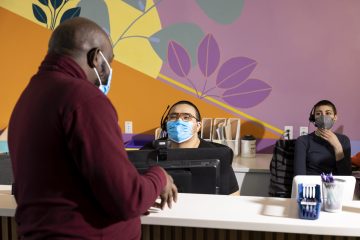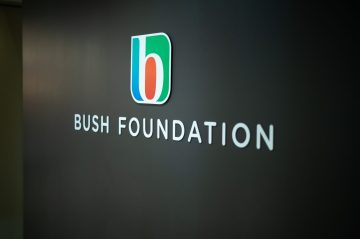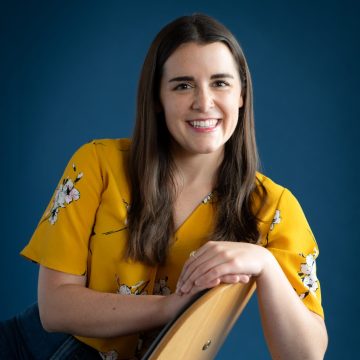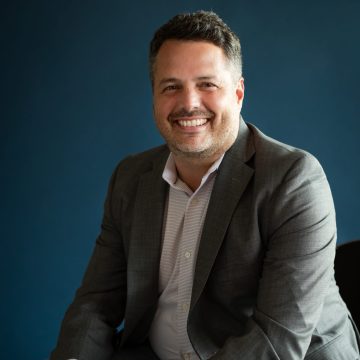Story
Branching Out
Family Tree Clinic has broadened its scope of services and its regional impact by helping transgender people get the hormone care they need
DATE
May 19, 2022

By Katie Dohman
About a decade ago, Nathalie Crowley drove 150 miles each way every two weeks from Duluth to the Twin Cities to get access to gender-affirming hormone care, therapy, hair removal, and other wellness services she needed, but couldn’t get anywhere closer to home.
At the time, very few providers offered hormone care, and transgender people living outside the Twin Cities metro area had to travel major distances to get it. Five years later, the number of providers had grown only slightly.
Crowley eventually moved to the Twin Cities, and when a position opened on the board of Family Tree Clinic — a community clinic focused on providing comprehensive sexual and reproductive healthcare — she jumped. Finding a mix of her professional skills and lived experience a match, she joined the staff in 2018 as a patient coordinator helping patients with financial aid, insurance and other services they desperately needed to access better healthcare.
Now, Crowley is the director of people and culture at Family Tree, focused on fulfilling the organization’s mission. “Family Tree wants to end health disparities, and we need to start with that in our own backyard, with our own staff,” she says. “But it’s also making sure we have a culture steeped in acceptance of people’s gender and sexual identities, racial identities, and make sure that it’s a safe place for everyone to be. What we want is for the people who are providing care and staffing the clinic to really represent the people we are serving.”
That’s a big job, especially for a small-but-mighty nonprofit.
There’s been a complete transformation in Family Tree’s patient population, especially over the last decade, and primarily in the context of LGBTQ patients. In 2009, just 9% identified as LGBTQ. Today, it’s about 60%.
Additionally, Family Tree’s patients are about 50% Black, Indigenous, and people of color (BIPOC). About a quarter are uninsured. Another 30% rely on medical assistance programs, and nearly three-quarters meet low-income guidelines.
There are a lot of factors that account for the stratospheric jump in LGBTQ patients, but at the heart of it is the willingness to change with, and prioritize, patient needs.
“You can come as you are here,” Family Tree Clinic Medical Director and Certified Professional Midwife Jennifer Demma says. “However you feel on that day, you’re still seen and heard and valued and respected. We don’t need you to be someone else.”
That includes a trauma-informed approach, with consent at the heart of every interaction. It means taking every chance to make sure patients feel seen, heard and understood in their gender. It feels revolutionary, but to Family Tree, it’s just how healthcare should be delivered.
As care has improved, demand has skyrocketed — including for gender-affirming hormone care for trans people. This program, piloted in 2015 (in part thanks to grants from the Bush Foundation and PFUND Foundation, a regional LGBTQ grantmaker) is now getting ready to spread its wings across the region.
The Bush Foundation deepened its investment to $757,000 in 2021 to help Family Tree scale its gender-affirming care, expand service offerings and train more providers across greater Minnesota, North Dakota and South Dakota. In doing this, Family Tree’s successes can be decentralized and shared with other providers, helping to bring this approach to care closer to more people. From there: driving systems change.
“We’re not doing anything at Family Tree that’s not possible at any other healthcare places, but it’s about shifting what is valued,” Demma says. “We have to dismantle the systems we’re a part of to be in alignment with those values, and support changing who’s doing the work.”
Family Tree’s Roots
To understand the work, and the people doing it, a quick rewind: Since 1971, Family Tree has been a community–based sexual and reproductive healthcare clinic providing services such as birth control and sexually transmitted infection testing to all on a sliding scale.
The clinic’s reputation grew as a comprehensive, affordable, nonjudgmental place to get healthcare. The patient load, and eventually the waitlist, grew accordingly. Until 2020, providers and staff were stuffed into a converted school in St. Paul, tending to an increasingly diverse patient population with a wider range of needs for healthcare resources and services.
Dylan Flunker, research and policy manager at Rainbow Health, a clinic and advocacy center for equitable healthcare access, centers his work on research around LGBTQ people and their access to and experience with healthcare. He says the organization has used Family Tree Clinic as a case study in how to be an inclusive care provider. “They iterate in a way that I don’t see a lot of other organizations are willing to,” he says. “They have the willingness to try something, keep what works, and they don’t just take one step onto the path. They continue to identify the next step to make sure everyone is getting the care they need.”
In November 2021, Family Tree expanded into a federally designated “medically underserved” neighborhood on Nicollet Avenue in Minneapolis. The two-story building is a bright, airy space that has come to function as much a community center as a clinic; one that will allow for 10,000 more patients — who may be otherwise falling through the cracks — on top of the 22,000 it already sees annually.
A Growing Community
Family Tree has grown from a St. Paul family planning clinic to a regional leader in LGBTQ health, science-based sex education and culturally responsive care.
The transformation didn’t happen overnight. In 2009, Family Tree launched its LGBTQ Health Access Initiative, and in 2015, launched the Transgender Hormone Care Program pilot. The plan was to serve 30 people with gender-affirming hormone care in the first year. It served more than 100. Within three years, it had served 500 patients, and worked to train, consult with, and expand the number of providers who perform gender-affirming hormone care to create a broader network of providers.
Although gender-affirming hormone care is more widespread than ever, trans patients are still falling into big geographic and philosophical gaps, not to mention discrimination both legislatively and personally. In 2021, about 52 percent of Family Tree patients identified as trans, nonbinary or gender noncomforming — up from just 1 percent in 2009. Patients still regularly travel to Family Tree for care from seven states, Indigenous lands and Canada.
“That shows how pervasive the need is,” Demma says. “It’s not just hormone care. People are traveling from other states to get a physical and pap smear because they will be affirmed in their gender, and they can’t find that in the community they live in. They can’t find anywhere that doesn’t continue to harm, oppress, and marginalize a person who is just trying to get healthcare.”
Changing the Model
Dr. Kelsey Leonardsmith has been a family medicine physician at Family Tree since 2017 and the director of the child and adolescent transgender hormone care program since 2019. Their studies at Harvard gave them a peek into the first gender-affirming pediatric program in the country at Boston Children’s. They were “blown away by the power of interventions,” even though at the time they didn’t know pediatric hormone care would play a starring role in their practice. But after witnessing systems rife with medical discrimination and hearing traumatizing stories from LGBTQ community members, they knew they had a role to play in improving care.
“Trans folks have dramatically high rates of medical discrimination — they have almost universally experienced at least some form of prejudice in a medical environment,” they say.
Leonardsmith cites a 2020 survey in an adolescent medical journal that studied mental health outcomes between those who wanted hormone care and got it versus those who wanted hormone care and didn’t get it. “For the first group, there was a huge reduction in risk of suicide. That’s really striking,” they say. But even more alarming to them was that the number of people in the second group — those who wanted care but didn’t receive it — was 10 times larger than the first group.
Leonardsmith has been creating and supporting networks of providers who want to offer gender-affirming hormone care regionally, often through informal consultation. They point out that it doesn’t take many providers joining to dramatically increase access.
For Leonardsmith, it’s not just hormones that are considered gender-affirming care. “I always say to young people: ‘There’s no wrong way to have a gender and there’s no one path through your life. This your journey, not my journey, and I’m here to walk with you and help you match yourself to the tools I have to offer to help you live your best life.’”
Planting Seeds for the Future
Still, Family Tree needs more people trained and offering care.
“Part of the Bush Foundation grant can support the efforts we already have: partnerships with educational programs and to strengthen gender-inclusive content in their programs, whether that’s medical school, residency, nurse practitioner or midwifery programs,” Demma explains. “The ability to then reach and support providers in surrounding areas that maybe don’t have access to resources, or sometimes just need to have a trusting relationship where they can be vulnerable enough to ask questions and admit they don’t know something — to do it in a safe, responsible way.”
Rainbow Health’s Flunker adds that Family Tree staff could have approached this work with a scarcity mindset, focusing on keeping patients all to themselves. But they didn’t. “What I especially love is that they are looking at it from an abundance mindset: We have this knowledge, and we want everyone to be thriving in their home communities. That is one thing I think is amazing and revolutionary about the program. They’re not falling into the trap of seeking perfection over progress.”
At Family Tree, Crowley says lots of work has been done to make sure that the provider and staff roster reflects their patients, but there’s still work to do. And externally, there’s also a lot of hope: “[We can continue] to do that work on a larger scale, all over Minnesota and the upper Midwest, helping people get access to the wonderful care we provide. People are so, so hungry for it, and there is real desire from lots of providers who just don’t have the support system, so we’re excited to offer that.”
“We’re not in an ER, and we’re not EMTs, but we really are saving people’s lives,” Crowley continues. It’s a world she couldn’t have imagined when she was regularly traversing the state, seeking her own gender-affirming care just a decade ago. “Giving them a safe place to receive healthcare is so incredibly important. And it’s true for all the work we do — LGBTQ, trans, cis people — all the work we do is lifesaving in one way or another. We are making a really big difference.”
Katie Dohman is an award-winning freelance writer based in West St. Paul covering health, wellness, parenting, and other lifestyle topics. She lives with her husband, three kids, and four pets while they slowly renovate a century-old home.
Jenn Ackerman and Tim Gruber are a husband and wife photo team living in Minneapolis, MN. Despite their work taking them around the globe they love documenting life around the Midwest. They’ve been fortunate to work regularly for clients like National Geographic and The New York Times.
Continue reading
-

News
Opportunity to work with us
As part of our office move later this year, we are exploring possibilities for the build out of the ground floor of the building. We are in the early stages of this and considering different types of operating models and potential partnerships.
-

Staff note
Coordinating the work of our contact hub
We aim to be radically open in all that we do, and that includes being more accessible to more people and sharing what we learn along the way.
-

Staff note
Making every dollar work through impact investing
We have benefitted from the experience of other funders as we developed our impact investing approach. Now we are paying it forward and sharing what we have done and what we have learned.